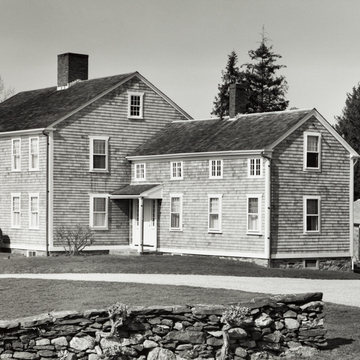Sited well above the road, this farm complex vividly recalls Tiverton's mostly vanished agricultural heritage—as well it should, with a history of cultivation that extends over nearly three centuries. William Durfee, who also engaged in shipping out of Newport, established the farm in the late 1690s, and some of the stone walls, stone outbuildings (possibly for slave quarters), and gardens may date to the late seventeenth or early eighteenth century. In 1768, his son Thomas demolished his birthplace and erected the present central-chimney farmhouse on its foundations. Its transomed entrance, probably an early-nineteenth-century addition, contains Neo-Gothic tracery, all simply capped by a bracketed entablature. The compelling image of this farm and its outbuildings cluster has long been appreciated: Pencil Points (1920) published the house, and the Garden Club of America's Gardens of Colony and State (1931) includes its gardens.
You are here
William and Thomas Durfee Farm
If SAH Archipedia has been useful to you, please consider supporting it.
SAH Archipedia tells the story of the United States through its buildings, landscapes, and cities. This freely available resource empowers the public with authoritative knowledge that deepens their understanding and appreciation of the built environment. But the Society of Architectural Historians, which created SAH Archipedia with University of Virginia Press, needs your support to maintain the high-caliber research, writing, photography, cartography, editing, design, and programming that make SAH Archipedia a trusted online resource available to all who value the history of place, heritage tourism, and learning.





